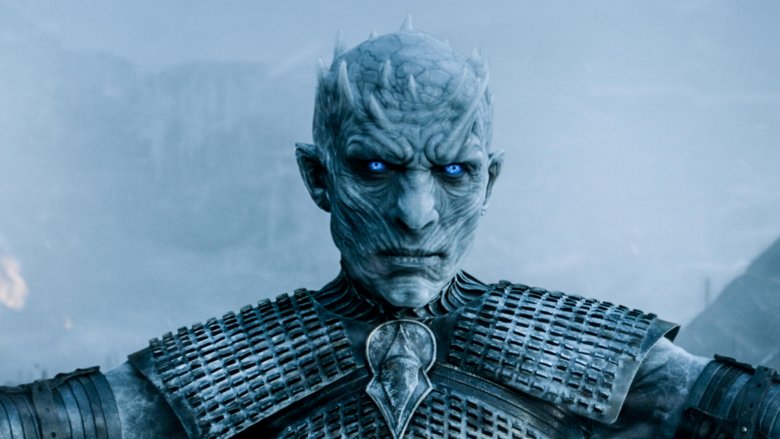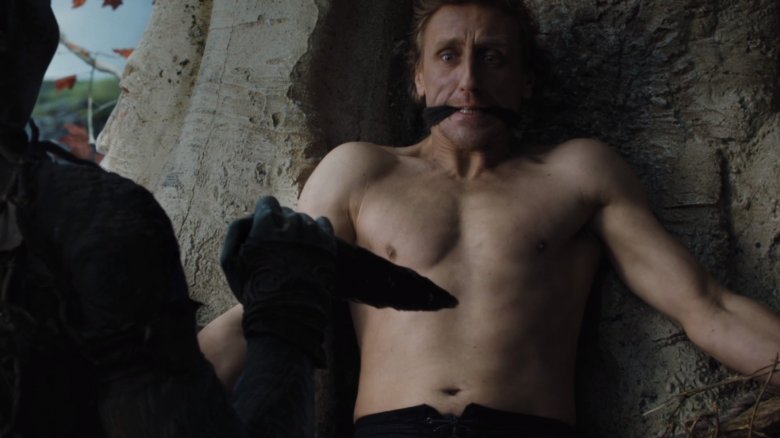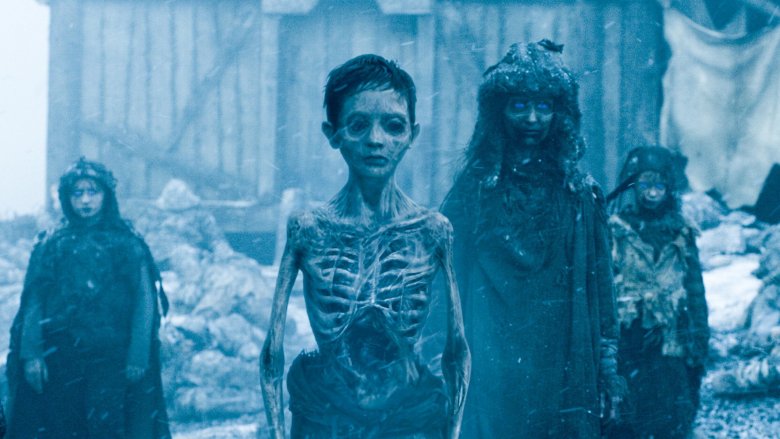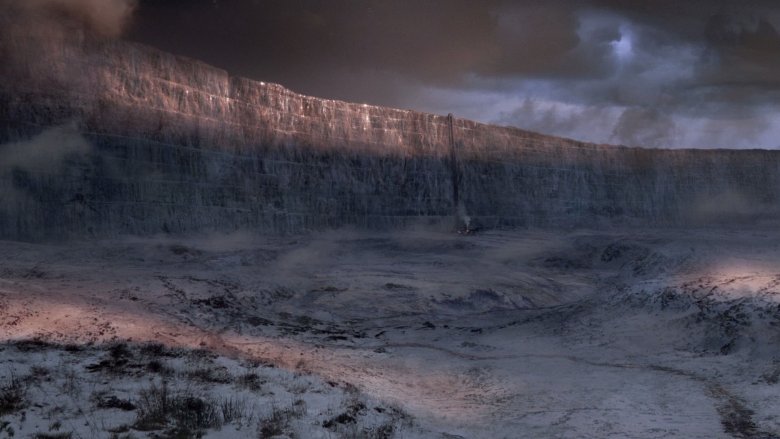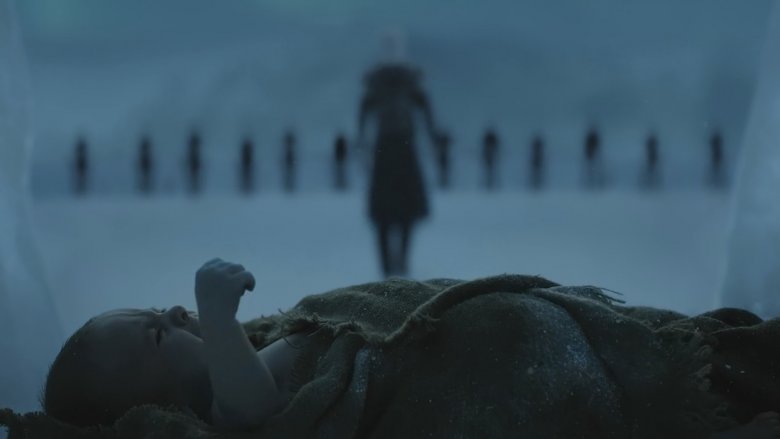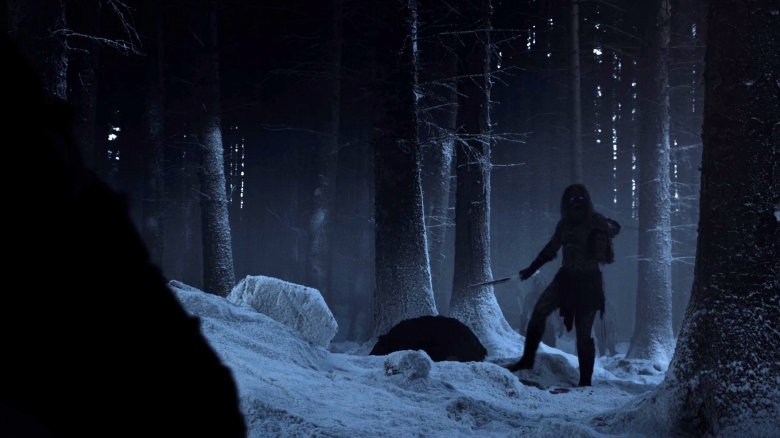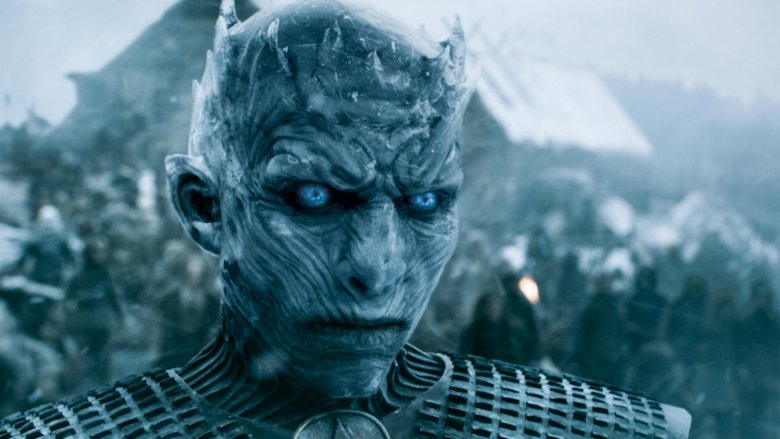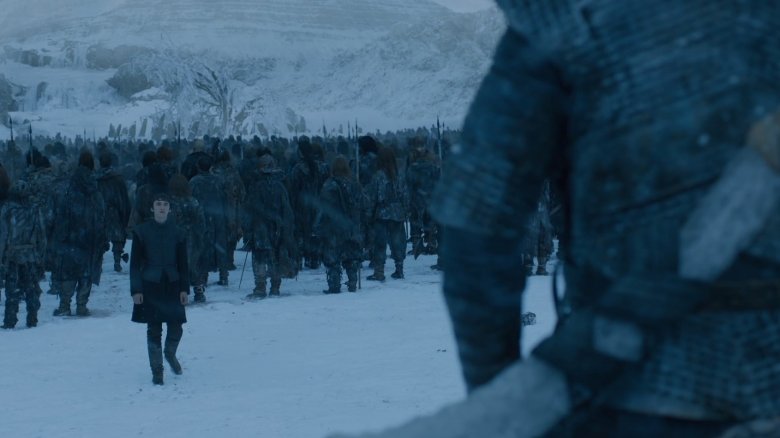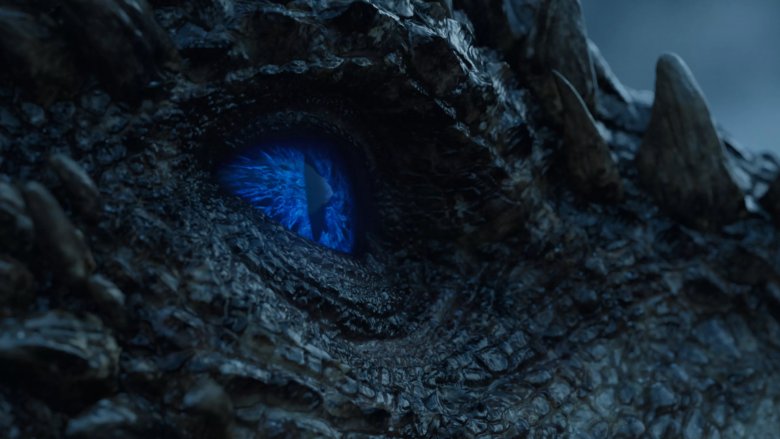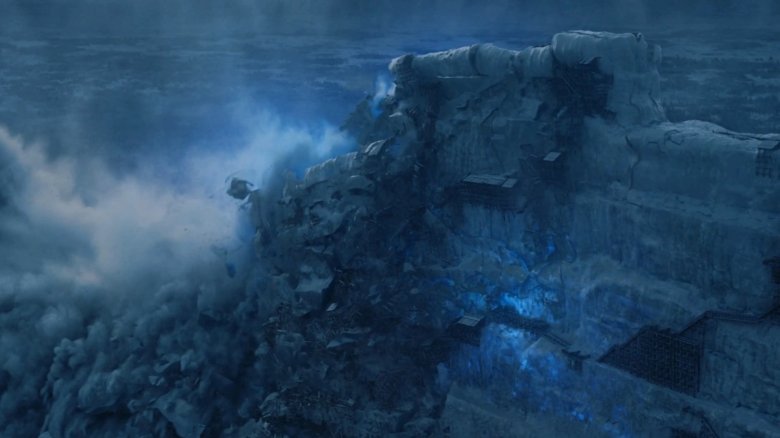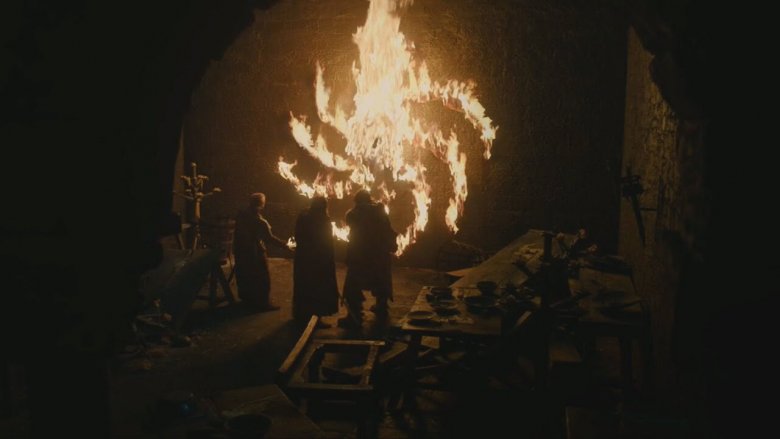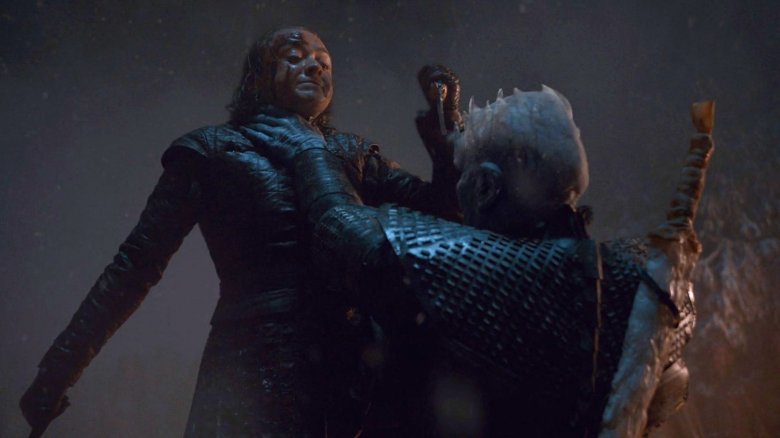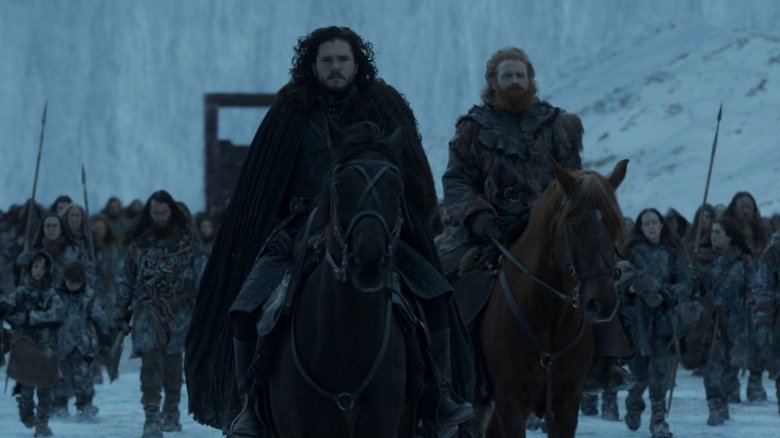The Entire Night King Timeline Explained
Game of Thrones might have come to an end, but that doesn't mean the audience's time in Westeros is over. No, we're not talking about the many spinoff shows currently filling the digital landscape with excited speculation, nor do we even mean the final two books of George R.R. Martin's A Song of Ice and Fire series. Those are eagerly anticipated, to be sure, but we're talking about the show itself. Fans, devoted to the series for years now, are going to be unraveling the final season and its implications for years to come. Hours will be devoted to understanding the ramifications of Bran's reign as King. Years can be spent exploring the future of Dorne. Someone, somewhere, is probably engaged in a furious debate over Brienne's preferred breakfast pastry.
One of the most tantalizing mysteries is that of the Night King, the enigmatic leader, creator, and general of the White Walkers and their shambling army of the undead. Though we have a rough understanding of his origins and mission, there's still so much to dig into as to why he did what he did, whether he might rise again, and just how he planned to take over the world beyond Winterfell. Take this handy timeline with you as you plumb his story's depths — just remember to bring your dragonglass dagger along. This is the untold truth of the Night King.
The Night King's desperate birth
The Night King's story begins with the story of Westeros. Before the First Men came, the Children of the Forest lived in pastoral harmony with the giants, their reverence for nature nourishing body and spirit alike. Though they forged no metal, they developed dragonglass (or as we know it, obsidian) into useful tools and arrowheads — and most importantly, developed their unique magic. Alas, this bliss was not to last: the First Men invaded the Children's land across a then-intact land bridge from Essos into what would become Dorne. They brought bronze, masses of people, and a thirst for conquest.
War ensued. Though the Children's magic was strong enough to shatter the land bridge, it proved no match for the thousands of First Men wielding sturdy metal weaponry. In a last-ditch attempt to save their way of life, the Children drove a dragonglass dagger into a captured First Man, and used their magic to transform him into an undead being of ice. Though it is unclear if this man turned against the Children immediately or if it took more time for rebellion to grow within his heart, the damage had been done. The Night King, first of his kind, had been born into a world utterly unprepared for his bottomless bloodlust.
The Long Night begins
Though the Children and the First Men did ultimately sign the Pact calling for an end to hostilities, the undead Night King disciples known as White Walkers had become creatures of entirely alien purpose. Details are murky here — Game of Thrones never supplied any specifics as to when the Night King turned his forces against warm-blooded life, nor even how long, precisely, their icy reign lasted. What is known is that the Night King and his Walkers invaded northern Westeros, and a generation suffered and died within the undead winter they brought. This became known as the Long Night, marked by the failure of crops, mass murder (by the sword, starvation, and sickness alike), complete darkness, and the destruction of organized settlements. It was, ultimately, the closest the Night King ever came to succeeding in his goal of wiping out all life — and, as Bran Stark later pointed out, all memory of life as well. The winter they brought promised no spring, no harvest, and no future at all.
The War for the Dawn is won
Though the Night King and the White Walkers never advanced beyond Westeros, their terror became so legendary that it inspired everything from Essosi stories of Azor Ahai to the idea of "a prince who was promised." Regardless of whether the Walkers were driven back by the Lord of Light's favor or old-fashioned tactics, they were ultimately pushed back to the polar wasteland through an enormous, conjoined effort of magic, luck, and engineering referred to as The War for the Dawn. Bran the Builder, wielding a powerful blend of magic and science, erected the Wall so that the blue-eyed menace might never return.
Millennia passed, during which the Night King and the Walkers became a long-ago threat, a distant peril, and, finally, a story meant to frighten children in the dead of night. So entrenched became this idea of the White Walkers as nothing but fictional monsters that, even by the show's finale, most Westerosi likely never knew the Walkers were real, let alone that they'd come close to dying at their frozen hands. Perhaps this was an intentional ploy on the part of the Night King — who, after all, would manage to gather warriors en masse against the creatures their nursemaids spoke of? The Long Night had given way to the dawn, and the Night King bided his time for 8,000 years.
Infant sacrifices for the Night King
At some point in the decades before the events of Game of Thrones, the Night King put out the call for male infants. Perhaps it was only ever an entreaty made to Craster, the Wildling hermit who viewers saw marrying his daughters and abandoning his sons in the forest beyond his Keep. Perhaps there were many Wildlings doing the same thing. What we do know is what happened to these children, as revealed in the season 4 episode "Oathkeeper:" they were taken to the Lands of Always Winter, laid upon icy altars, and turned into White Walkers by the Night King himself.
The process is simple, yet notably enigmatic. All the viewer sees is the Night King's finger laid upon the infant's cheek, followed the transformation of his eyes from their natural color to an inhuman blue. This is a notably different process than that of rising corpses as wights, involving a ceremony of assembled Walkers, a circle of icicles, and the involvement of the Night King himself. Yet we never learn how often it was done, if every Walker had the power to do this, nor how many human infants were turned over the course of the 8,000-year retreat. It, like so many things about the Night King and his subjects, would remain a mystery.
The Night King sends his forces out
After an undetermined point of corpse-and-baby-gathering had been reached, the Night King sent out his forces to harass, murder, and generally terrorize the Wildlings. One especially horrible manifestation of this campaign makes up the first scene of Game of Thrones' first episode. Recall the Night's Watch deserter beheaded by Ned Stark, the artfully arranged spiral of corpse parts, and the dark shadow with cerulean eyes that would be all the audience saw of the Walkers until the season 2 finale, "Valar Morghulis." Westeros remained largely ignorant of the threat — but some were not so lucky.
Evidence of their advance is all over the first few seasons of the show, from Osha's desperation to go south to the increasingly confident claims of the Wildlings. The Walkers were making a statement, and the Night King showed no interest in pulling back as the rumors grew. He likely was, in fact, very purposefully looking to sow that sort of fear. As the Wildlings grew more terrified, the Night's Watch grew divided as to how to deal with them. Dissent festered, culminating in such events as Jon Snow's murder, the rise and fall of Mance Rayder, and the mutiny against Lord Commander Mormont. The humans had been turned against themselves, and all the Night King had to do was be there to turn the corpses into his army.
The massacre at Hardhome
Years passed, comprising most of the first five seasons of Game of Thrones. Finally, after Wildlings climbed the wall, the Night's Watch came to understand the White Walkers as a clear and present danger, and thousands of corpses raised to fight against the living, it all came to a head in "Hardhome," the episode chronicling the terrible events at that very location.
Hardhome was the closest things the Wildlings ever had to a city. It's where Jon Snow, Tormund Giantsbane, and a handful of Nights' Watchmen and like-minded Wildlings traveled to urge its denizens to join them in the fight against the Walkers. Their negotiations were for naught, however: the Walkers attacked as boats set to sail to the Wall were just beginning to fill. An avalanche of wights overran the crude settlement, murdering thousands in a savage surge of brutality. In the midst of the slaughter, Jon Snow and a Walker foe discovered Valyrian steel's resiliency against Walker ice magic — and, immediately after, its ability to shatter the beings themselves. This discovery brought the Night King down from his perch on a clifftop into the middle of the sea of corpses his forces had made. Silently, he locked eyes with Jon Snow and raised the dead with a simple lifting of his hands. Those fighting on the side of the living might have learned something crucial about Valyrian steel, but it came at a terrible cost.
The Night King corners Bran
While Jon Snow and the Night's Watch were battling the Walkers with sword and shield, Bran Stark was on a crusade of his own. Under the tutelage of the Three-Eyed Raven and the Children of the Forest who lived with him, Bran learned to harness his psychic powers, discovering the origin of the Night King and the Children's culpability in his creation. Emboldened, he entered a vision on his own — only to be spotted by the Night King, who was able to grab Bran's arm across miles of distance and brand it with his mark, alerting him to Bran's presence in the corporeal world.
Despite the Children's magic, Summer's attack, Meera's swiftness, and Hodor's tragic sacrifice, the Walkers were not substantively stopped. Though the Three-Eyed Raven was able to pass on his powers to Bran, he still fell to the Night King's spear — along with many of what might have been the only group of Children left. As Bran detailed in Game of Thrones' final season, the Night King sought to eradicate all knowledge and memory of life from the world. In stripping Bran of his most important allies, protectors, and teachers, he managed to further that goal considerably.
The resurrection of Viserion
As the Night King neared the Wall, Jon Snow proposed something drastic: gathering a party of warriors to capture a wight that would prove the truth of the threat to Queen Cersei and her skeptical court. Though the grizzled band was, in fact, able to present the queen with a ravening, blue-eyed corpse, it came at tremendous cost. The Walkers and their army killed much of the group, including Thoros, the priest who repeatedly re-animated Beric Dondarrion, and Viserion, one of Daenerys' dragons.
The fact that Cersei didn't ultimately join forces with Daenerys and Jon in the war against the Walkers is cruel enough. Yet the worst part of this loss was the fact that the Night King was able to raise Viserion as a wight dragon, complete with the ability to breathe massively destructive blue fire. Jon Snow might have accomplished what he set out to do in the most literal sense, but on a much more important scale, this was yet another victory for the Night King. The forces of good were down a dragon, a miracle-wielding priest, and Benjen Stark, laid to rest at last. The army of death had only grown in size and sinister capabilities.
After 8,000 years, the Wall falls
It wasn't long before the Night King decided to put his brand new steed to the test. Leading untold thousands of resurrected corpses, a host of mounted White Walkers, and a fearsome number of undead beasts, the Night King descended upon Eastwatch-by-the-Sea with frozen fury. One fiery assault from Viserion was all it took to pierce the wall — thousands of tons of enchanted ice, rock, and masonry fell beneath the eerie blue flame, leaving a clear road through to Westeros. It was this shocking image that closed out Game of Thrones' seventh season: the last, best defense of the living, torn asunder at last. The Night King flew ahead to the North, his forces massed and ready. The Wall, which had stood for 8,000 years, had fallen before him. All he had left to do was massacre his prey, starting with Winterfell and all the living souls who dwelt within.
The Night King reaches the Last Hearth
The Night King advanced upon the North quickly. His first stop was the Last Hearth, the seat of House Umber. Though battered by the war and tasked with maintaining a remote position between the unknown wastes and the comforts of Winterfell, Umber was a proud house with a long and glorious history. In the aftermath of the Battle of the Bastards, the house was headed by Lord Ned Umber, a ten-year-old looking to regain the honor lost in his family's backing of the Boltons. The little Lord supports Jon Snow's decisions as King in the North with eagerness, and pledges fealty "now and always."
Unfortunately, the Night King made that "always" quite a bit shorter than it should have been. The Last Hearth was the Walkers' first stop on the way to Winterfell, and after slaughtering Ned Umber and his household, they pinned him to a wall surrounded by their characteristic spiral of body parts. Though Beric Dondarrion prevented him from wreaking havoc as a wight with his flaming sword, Umber's murder stands as one of the saddest crimes the Night King perpetrated.
Arya Stark brings on the dawn
With the Wall breached, the armies massed, a dragon risen from the grave and every ounce of dragonglass mined from beneath Dragonstone, there was nothing left to do but make war. The Night King descended upon Winterfell like a tempest, swallowing the fires of Dothraki warriors, trenches of flame, trebuchets, longswords, and valiant charges alike within his icy darkness. He had a goal in mind, beyond mayhem: to find Bran Stark, the new Three-Eyed Raven, and kill him.
Bran knew this, and allowed himself to be used as bait. The stakes were high — Theon Greyjoy died in his efforts to protect Bran, the dead in the crypts of Winterfell were raised by the Night King's powers, and Jon Snow resorted to facing Viserion with nothing but a sword. But out of nowhere came Arya Stark, honed into one of the finest warriors alive by a series of lessons imparted by a long line of teachers from her original "dancing master," Syrio Forel, to the murderous Faceless Men. Though the Night King likely thought he'd foiled her when she caught her by the arm holding the Valyrian steel dagger, he didn't expect her to drop it into her other hand. With one swift stab the Night King was slain, along with all the creatures he'd created. The army of the dead was gone. An eternity of winter had been avoided. And the White Walkers, with the death of their leader and progenitor, instantly became extinct.
A world without a Night King
Thus ended the war audiences had been teased with for years. This was no mere delay of hostilities, as happened in the end of the Long Knight thousands of years prior — this was a conclusive extermination. With Arya's devastatingly precise stab, she vanquished the White Walkers as a race. It is likely, in fact, that as years pass, only those who take on the mantle of the Three-Eyed Raven will remember the Walkers ever existed.
But the Night King's reign of terror lives on in the hearts of Game of Thrones' principal characters. Jon Snow, free at last to live beyond titles and great houses, cannot ever rid himself of the evil he stared down. Bran, elevated to king, is also tasked with remembering what brought the Walkers about in the first place. Arya, off on adventures beyond the borders of Westeros, will doubtlessly be followed everywhere she goes by the fact of her great, world-saving deed. These, and many other characters, now live in a Westeros as defined by the Night King's absence as it was by his presence. How does a king best prevent the rise of such a villain ever again, without revealing the process itself? What sort of society will Jon be part of, without a Wall and what it held back? The Night King might be dead, but his memory will linger on for years to come — if only as a terrifying fairytale.
